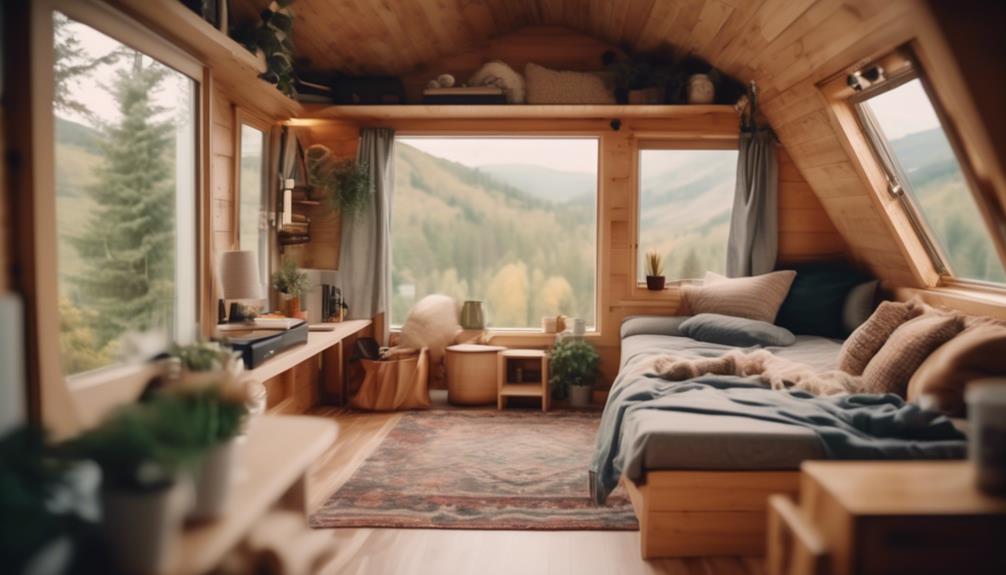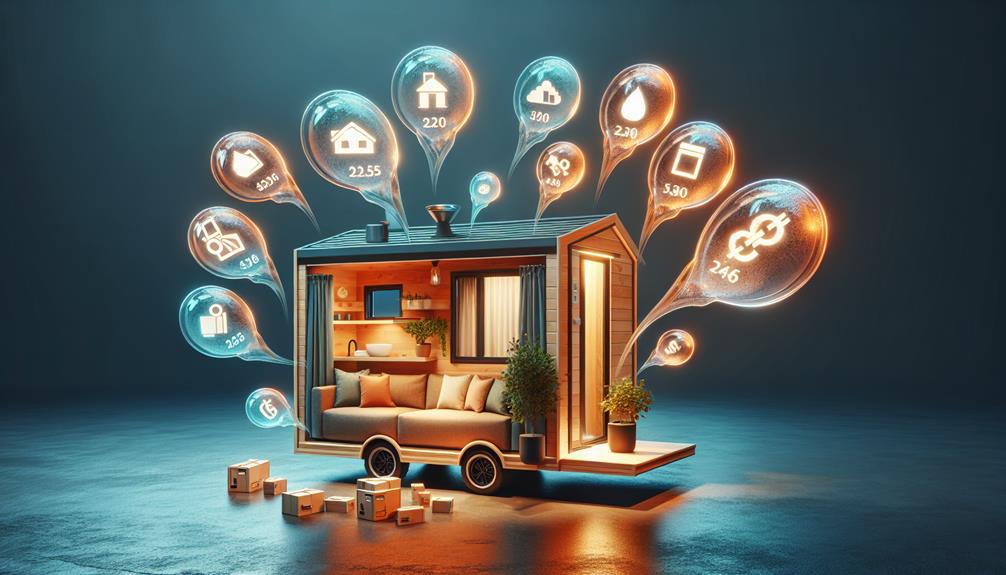As you tiptoe into the realm of minimalist living, you may find that the financial footprint of a tiny home isn't as minuscule as its square footage suggests. You're considering joining the movement that's sweeping the nation, attracted by the allure of simplicity and the promise of a smaller carbon footprint.
But as you weigh your options, it's crucial to understand that the initial price tag of around $52,000 is just the beginning. With factors like land acquisition, customization, and long-term maintenance to consider, you'll want to arm yourself with knowledge to avoid unexpected financial surprises.
As you contemplate whether a tiny home aligns with your budget and lifestyle, consider the complexities of such an investment, and the hidden costs that often lurk beneath the surface of these charming, compact dwellings. What you discover could significantly influence the decisions you're about to make.
Key Takeaways
- Building expenses for a tiny home can range from $10,000 to over $100,000 depending on DIY or professional builders and the use of high-quality materials.
- Land acquisition costs vary by region and can range from $2,000 to $13,000 per acre, with property taxes and zoning laws affecting the budget.
- Choosing smaller versions of appliances and investing in long-term cost-saving installations like water heaters and solar panels can help manage expenses.
- Regular maintenance, upkeep, and proper insurance are crucial for functionality, resale value, and budgeting for a tiny home.
Initial Building Expenses
When planning to construct a tiny home, you'll find that initial building expenses can vary widely, typically ranging from $10,000 to over $100,000. The cost to build hinges on whether you opt for a DIY approach or professional builders.
Selecting high-quality materials will increase your average cost, but ensures longevity and sustainability. If you're envisioning a custom-built tiny home, anticipate tiny house costs to skew higher due to bespoke designs and specialized components.
Moreover, don't overlook the expenses linked to the land, including building permits and taxes, which are pivotal to your budget. Foundation costs are also significant; a custom tiny house on a permanent site typically costs more than one designed for a trailer, offering mobility and potentially lower initial outlays.
Land Acquisition Costs
Securing a plot of land for your tiny home entails not just the acquisition cost, which can range dramatically by region, but also the consideration of property taxes and zoning laws that may affect your budget. When purchasing a tiny home, you're entering a unique segment of the real estate market where the cost of land and regulations and restrictions can be as pivotal as the design of your home itself.
| Factor | Impact on Land Acquisition Costs |
|---|---|
| Regional Variations | $2,000 to $13,000 per acre |
| Property Taxes | Ongoing fiscal responsibility |
| Zoning Laws | Permission for tiny home placement |
| Utilities and Financing | Additional upfront & long-term costs |
Carefully analyze land costs in your desired area, especially if you're considering a rural property, to ensure financial feasibility and regulatory compliance.
Amenities and Features

Beyond the initial investment in land, the amenities and features you select for your tiny home will significantly impact your overall costs. When choosing amenities, consider the balance between innovation and budget. Here are key factors to appraise:
- Appliances: Opt for smaller versions of appliances, which are specifically designed for the average tiny house, to manage additional costs effectively.
- Utilities: Installations like a water heater, solar panels, or a septic tank can be substantial investments, but they also offer long-term savings and self-sufficiency.
- Material Quality: Investing in a prefab tiny house may save on initial costs, but ensure the quality of materials and construction, such as a standing seam metal roof, to avoid future expenses.
- Design: Hiring Interior Designers might increase your budget, yet the right interior design maximizes space utility and incorporates cost-saving innovations.
Maintenance and Upkeep
To ensure your tiny home remains in top condition, you'll need to factor in the costs and efforts of regular maintenance and upkeep. Just like traditional home ownership, ongoing maintenance is crucial to preserve the home's functionality and resale value. Considering additional factors like storm damage prevention can also affect the total cost. Building your own tiny house can simplify future Home Improvement tasks.
Here's a breakdown of potential maintenance areas:
| Maintenance Area | Average Costs/Considerations |
|---|---|
| Heating/Cooling Systems | Annual servicing required |
| Air Leakage | Regular checks around openings |
| Appliances | Follow manufacturer guidelines |
| Utilities | Included in additional costs |
Additional Considerations

While considering the regular maintenance costs for your tiny home, you should also account for additional expenses such as utilities and unique home features that could impact your budget. Here are some key additional considerations:
- Building Materials: Opt for innovative, sustainable materials that offer long-term savings, though they may have higher upfront costs.
- Financing Options: Explore various loans and grants tailored for tiny homes; some lenders now specialize in this market.
- Permits and Inspections: Local building codes may require permits and inspections, which affect both timeline and budget.
- Homeowners Insurance: Ensure you have adequate coverage, considering the risks associated with tiny living and potential savings from lower premiums.
Long-Term Financial Impact
Over the years, owning a tiny home can significantly affect your finances, requiring a thorough evaluation of recurring expenses such as maintenance, utilities, property taxes, and insurance.
| Expense Category | Financial Impact |
|---|---|
| Maintenance | Annual servicing; potentially lower if you build it yourself. |
| Utilities | Generally lower due to reduced space. |
| Property Taxes/Insurance | Varies by location; often lower but essential for budgeting. |
| Depreciation | Tiny houses on wheels may depreciate in value, unlike traditional homes. |
| Longevity | Quality construction can ensure tiny homes last just as long as traditional homes. |
Investing in a tiny home could save money in the long run, but it's crucial to consider these factors to understand the overall cost and financial impact.
Frequently Asked Questions
What Is a Good Budget for a Tiny House?
When budgeting for a tiny house, consider land costs, custom designs, and building materials. Financing, minimalist budgeting, and potential DIY savings can offset expenses. Factor in zoning, off-grid options, and resale value based on size.
Is It Really Cheaper to Live in a Tiny House?
Living in a tiny house can be cheaper, emphasizing a minimalist lifestyle and space efficiency. You'll save on utility bills but consider zoning laws, hidden costs, insurance premiums, and potential resale value adjustments.
Are Tiny Homes Worth the Money?
Tiny homes are like origami, maximizing space through clever design. They promise a lifestyle shift with a smaller environmental footprint, but you'll face downsizing challenges and zoning laws that may affect investment return.
How Long Do Tiny Homes Last?
Your tiny home's durability hinges on material selection, weather impacts, and maintenance routines. High-quality construction, resilient design, solid foundation options, and regular upgrades can enhance longevity, potentially increasing its resale value and warranty offerings.
Conclusion
In conclusion, tiny home costs are a diverse mix. You're weighing a thrifty self-build against a high-end abode. Land and luxury can inflate your bill, yet a DIY spirit curbs expenses. Regular maintenance is your silent steward of value, while cutting-edge amenities may beckon your wallet.
Ponder the initial outlay versus long-term savings—your tiny home's price tag isn't just a purchase, but an investment in your lifestyle's blueprint.

